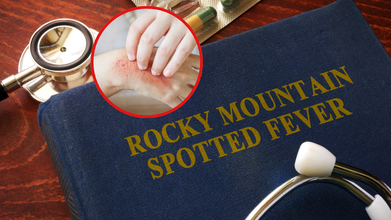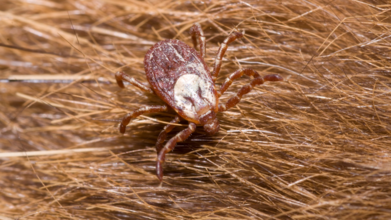- Health Conditions A-Z
- Health & Wellness
- Nutrition
- Fitness
- Health News
- Ayurveda
- Videos
- Medicine A-Z
- Parenting
- Web Stories
Canada Reports First Tick-Borne Rocky Mountain Spotted Fever, How To Spot The First Symptoms

(Credit - Canva)
Quebec has reported a case of Rocky Mountain spotted fever, a potentially deadly tick-borne disease. Reports suggest that the fever was likely acquired in Ontario or Quebec, as this disease was reported in Ontario earlier this year.
Here is what you need to know about the disease, how fatal it is, risk factors and symptoms you should look out for.
What Is Rocky Mountain Spotted Fever (RMSF)?
According to the Centers of Disease Control and Prevention, RMSF is a serious illness caused by bacteria and spread through the bite of an infected tick. It can be deadly if not treated early.

How To Spot The First Symptom of RMSF?
The first signs of RMSF can be vague and feel like other illnesses, including fever, headache, and muscle pain. The illness can get worse very quickly. A rash is a common symptom, but it often appears 2 to 4 days after the fever starts, which can make it hard to diagnose early. The rash can look like red splotches or tiny dots.
If you get sick after being bitten by a tick or spending time in a wooded or brushy area, you should see a doctor right away.
What Are The Long-Term Effects of RMSF?
RMSF is a serious disease that does not become a long-term, chronic infection. However, a severe case can lead to permanent damage, such as hearing loss, mental disability, or even the loss of limbs due to blood vessel damage.
There is no vaccine for RMSF. The best way to protect yourself is to prevent tick bites on yourself, your pets, and in your yard. Ticks are most active from April to September, but you can be exposed to them year-round.
Because RMSF can be so dangerous, CDC explains that doctors often start treatment with an antibiotic called doxycycline as soon as they suspect the illness, even before lab test results are back. This is because test results can take weeks to return. Doxycycline is an approved treatment for people of all ages and is crucial for preventing severe illness and death. However, please make sure you get yourself checked out before you take any medication.
Dougie Imrie Announces Death Of 20-Day Old Baby Daughter Born 14 Weeks Premature: What Are The Risks Of A Preterm Baby?

Morton manager Dougie Imrie announced the death of his baby daughter, who was born 14 weeks premature and weighed 1ib and 4 ounces. His daughter, Remi was 20 day old when she left the world. Remi was also put in neonatal intensive care unite at Wishaw Hospital and on Wednesday the announcement of her passing away was made.
He made the announcement on X, formerly Twitter, and wrote: "Our girl got tired in the early hours of Tuesday morning & decided it was time to rest 'If love could have saved you, you would have lived forever'.
He also wrote: "20 days of loving you, Remi, I hope you know how much you were loved, and we will cherish the short time we got to spend with you, a true wee fighter from the minute you were born."

The Greenrock Morton Football Club also paid tribute, calling it a "profound loss". The club wrote: "The Greenrock Morton Football Club family are devastated to learn of the tragic passing of Remi Imrie. The heartfelt condolences of all associated with the club go to Dougie Imrie, his partner Lauren and the full family at this extremely sad time. Greenock Morton at this time requests the privacy of the family as they try to come to terms with this profound loss, and we will continue to provide our full support."
Are Premature Babies Prone To Risks?
When a baby is born before 37 weeks of pregnancy, it is called preterm or a premature birth. The earlier the birth, the more serious the health risks to the baby. In most cases, preterm babies require special care in a NICU.
Some of the most common health conditions that can affect a premature baby are:
- Anemia, or not having enough healthy red blood cells
- Apnea of prematurity or temporary pauses in breathing
- Bronchopulmonary dysplasia, respiratory distress syndrome or underdeveloped lungs
- Intraventricular hemorrhage, or bleeding in their brains
- Newborn jaundice or hyperbilirubinemia, which means there are high levels of bilirubin in their blood.
- Necrotizing enterocolitis, or inflammation of their intestines
- Neonatal sepsis, or blood infection
- Patent ductus arteriosus (PDA), or abnormal blood flow in their hearts
- Retinopathy of prematurity, or underdeveloped blood vessels in their eyes
ALSO READ: Your Baby’s First 28 Days Are Critical, 5 Neonatal Health Problems Parents Can’t Afford To Miss
Premature babies are also at a higher risk of developmental challenges during childhood, which includes:
- Cerebral palsy
- Hearing and vision problems
- Learning disabilities
- Poor growth
- Problems with communication or social development
Some other risks that lure upon the mother who delivers a preterm baby are:
- Anxiety
- Postpartum depression
- Post-traumatic stress disorder (PTSD)
- Problems bonding with their baby
"Premature babies are born with most of their organs, but their organs are not mature enough to function," notes Dr Avneet Kaur, neonatologist and Pediatrician at the Apollo Cradle Hospital. "So we have to give them that much maturity till they reach that level of maturity themselves and maintain all those organ functions," she explains.
While the premature babies are in NICU, they are kept in incubators, explains the doctor. The babies are also given infusion drips so enough nutrition also reaches their bodies. The infusion drip is used to allow essential nutrients like protein, carbohydrates, etc., which a baby who is not born preterm would not need. "Preterm babies are functionally fragile, so we have to support them in every manner," she says.
Frank Caprio, 'Nicest Judge In The World' Dies At 88 Due To Cancer

Credits: Instagram
Just a day after "the nicest judge in the world", Judge Frank Caprio, 88, asked his followers from a hospital bed for their prayers, his relatives confirmed his death on Wednesday. His popular social media pages had already announced his death after a cancer diagnosis.
He earned his nickname "the nicest judge in the world" for his years on the Emmy-nominated show "Caught in Providence", and also for his social media presence. He had millions of followers. He crossed 3.3 million followers on Instagram and 1.6 million on TikTok.
The post that announced his death read: "He will be remembered not only as a respectable judge, but as a devoted husband, father, grandfather, great grandfather and friend. His legacy lives on in the countless acts of kindness he inspired. In his honor, may we strive to bring a little more compassion into the world - just as he did every day."
The Cancer Journey Of "The Nicest Judge In The World"
It was in 2023, that Caprio announced that he had been diagnosed with pancreatic cancer, one of the most aggressive types. He finished his radiation treatments in 2024 and published a new book. He soon returned to social media, and announced that his cancer has come back.
He said, "Last year I asked you to pray for me, and it's very obvious that you did, because I came through a very difficult period. Unfortunately I've had a setback and I'm back at the hospital." He also added: "I believe the almighty above is watching over us. So please remember me."
Read: TV’s ‘Nicest Judge’ Frank Caprio Shares Heartbreaking Cancer Update: ‘Keep Me In Your Prayers’
For almost 40 years, Caprio presided over hearing in Providence, Rhode Island. He was appointed in 1985 to the Providence Municipal Court and served as a chief judge until his retirement in January 2023. He had been hearing everyday from individuals who were saddled by parking tickets, small infractions and personal dilemmas. He had waived off fines for the low-income groups, is known for his sharp humor to calm the worried defendants. One of the things he would say was: justice can be more than just punishment, it can also be compassion. His motto was to find a human behind every case. This is what has earned him the nick of "the nicest judge in the world".
Pancreatic Cancer Recurrence
According to Florida's Moffitt Cancer Center pancreatic cancer recurrence can develop after a patient completes an initial course of treatment and experiences a period of time during which there is no evidence of cancer being present.
However, there is always a chance that some cancer cells will survive treatment. Over time, residual cells begin to grow and form recurrent cancer.
Where Can It Reappear?
The cancer can reappear locally within the pancreas, or regionally within nearby lymph nodes or distantly in other parts of the body. This is why it is important for a pancreatic cancer patient to have regular medical checkups to ensure that any health changes are identified, evaluated and treated.
As per a 2023 study published in the World Journal of Surgical Oncology, Pancreatic ductal adenocarcinoma (PDAC), one of the most common forms of pancreatic cancer is one of the most aggressive cancers, with surgical resection offering the only potential chance of cure.
Yet, notes the study, recurrence remains a major concern, often occurring early and drastically reducing survival prospects.
The study analyzed 403 patients who underwent surgery for PDAC shed light on how and why recurrence happens. Over a median follow-up of about 26 months, nearly 70% of patients experienced recurrence, with timing proving to be a crucial factor. Roughly 15% saw the cancer return within the first six months, 23% between six and twelve months, while the rest either recurred later or did not experience recurrence at all.
What Are The Risk Factors For Early Recurrence
The study identified several clinical features strongly linked to early recurrence. Elevated levels of the tumor marker CA19-9 before surgery, a higher modified Glasgow Prognostic Score (mGPS) reflecting systemic inflammation and poor nutritional status, and positive peritoneal cytology were all associated with recurrence within the first 6 months.
For recurrence within 12 months, positive peritoneal cytology remained an important risk factor. In addition, lymph node metastasis and the absence of adjuvant chemotherapy after surgery were also significant contributors. Patients who received chemotherapy or chemoradiotherapy before surgery showed the same pattern of risk, suggesting these factors are consistent across treatment strategies.
California Resident Tests Positive For Plague, Officials Trace Case Back To Lake Tahoe Flea

Credits: Canva
Health officials in California have confirmed that a South Lake Tahoe resident tested positive for the plague, the centuries-old disease that killed millions during the Black Death. The individual is believed to have contracted the infection after being bitten by an infected flea while camping near the Lake Tahoe Basin. According to El Dorado County Public Health, the patient is receiving care and recovering at home.
“Plague is naturally present in many parts of California, including higher-elevation areas of El Dorado County,” said Kyle Fliflet, the county’s acting public health director. “It’s important that individuals take precautions for themselves and their pets when outdoors, especially while walking, hiking and camping in areas where wild rodents are present.”
Though most people associate the plague with medieval Europe, the bacterium that causes it—Yersinia pestis—still circulates in parts of the United States. The Centers for Disease Control and Prevention (CDC) estimates an average of seven human cases occur each year nationwide.
Also Read: What History Teaches Us About Plague? Are There More Than One Type?
Most of these cases are sporadic, linked to fleas feeding on infected wild rodents such as ground squirrels and chipmunks. California, Arizona, New Mexico, and Colorado report the majority of cases. While the disease is now treatable with common antibiotics, untreated infections remain dangerous and potentially fatal.
In El Dorado County, plague activity is not unusual. State monitoring programs have detected Y. pestis exposure in at least 45 wild squirrels and chipmunks in the Lake Tahoe Basin since 2021. Most recent human case of plague in the region occurred in 2020 and was due to flea exposure.
How The Plague Spreads?
Most common way of transmission is by being bitten by an infected flea, but people can also get infected through handling infected animals or less commonly from pets like cats and dogs that are infested with fleas. There are three main forms of plague.
Bubonic plague – Most frequent, resulting from flea bites. The signs and symptoms are painful, swollen lymph nodes (buboes), fever, chills, headache, and weakness.
Septicemic plague – What happens when bacteria multiply in the blood, leading to bleeding beneath the skin, pain in the abdomen, and shock.
Pneumonic plague – Rarest but deadliest variety. It occurs when infection reaches the lungs and can be spread person to person through respiratory droplets.
More than 80% of U.S. cases are bubonic. If diagnosed early, antibiotics such as streptomycin, doxycycline, or ciprofloxacin can cure the disease. Without treatment, however, mortality remains high.
The term "plague" usually brings to mind the Black Death that caused an estimated 25 million deaths in Europe in the 14th century. That epidemic spread quickly from rat and flea populations in densely populated cities.
In the United States, the most recent rat-to-human plague outbreak took place in Los Angeles in 1924–1925. Since then, cases have been mostly confined to rural settings where people come in contact with wild rodents.
Only last month, an Arizona patient succumbed to pneumonic plague, highlighting that though unusual, the illness remains dangerous, especially when diagnosis is late.
How Did Lake Tahoe Become A Hotspot for Plague
Lake Tahoe’s mix of wilderness, high elevation, and rodent populations makes it one of California’s plague monitoring hubs. The California Department of Public Health (CDPH) routinely tests rodent populations, especially ground squirrels and chipmunks, for signs of Y. pestis exposure.
Officials stress that the presence of plague in wildlife does not mean widespread human danger. Instead, it highlights the importance of preventive measures for campers, hikers, and residents. Recommended precautions include:
- Using insect repellent containing DEET when outdoors
- Wearing long pants tucked into boots to minimize flea exposure
- Avoiding contact with wild rodents, dead animals, or their burrows
- Never feeding squirrels or chipmunks
- Keeping pets leashed or at home, and treating them with flea prevention
The South Lake Tahoe patient’s infection is believed to stem from a flea bite during a recent camping trip. Local health officials are investigating the case and have issued public advisories to remind residents and visitors about safety practices.
While the patient’s identity has not been disclosed, officials confirmed that they are receiving proper medical care and are expected to recover. The case has sparked renewed efforts to remind the public that while plague is rare, awareness is essential.
Is Plague Still A Cause Of Concern?
Globally, plague continues to cause outbreaks, particularly in parts of Africa, Asia, and South America. The World Health Organization reports several hundred cases per year, with Madagascar being one of the most affected countries.
In the United States, where public health infrastructure and antibiotics are readily available, cases are usually isolated and treatable. Still, experts say that ignoring plague entirely would be a mistake. Rodent populations are reservoirs for the bacterium, and climate change, increased outdoor recreation, and human encroachment into wildlife habitats may increase opportunities for transmission.
The South Lake Tahoe case is a reminder that ancient diseases are not fully relegated to history books. But unlike the Middle Ages, modern medicine provides effective tools to treat and contain outbreaks.
For residents and visitors, the takeaway is practical rather than alarmist: enjoy the outdoors but take precautions. For health authorities, it is a call to continue surveillance, public education, and rapid response when rare cases occur.
As Kyle Fliflet put it, “Plague is naturally present in many parts of California…It’s important that individuals take precautions for themselves and their pets when outdoors.”
© 2024 Bennett, Coleman & Company Limited

